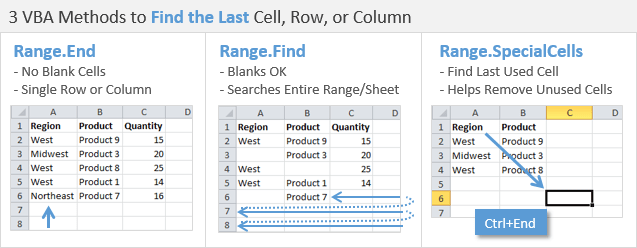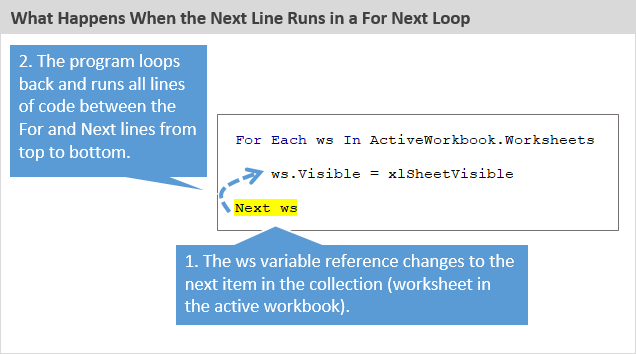

- Excel vba on step back in loop range full#
- Excel vba on step back in loop range code#
It’s often used because, in most situations, the limits of the variable type won’t be reached.
 In case your process exceeded the limit of even a long variable, you will have to restructure your For-Next loop to use the “For Each element In group” convention.īut even with such limitations, this is still a very useful method. Declaring a Double variable type won’t solve the limitation. Declare a Long variable instead, so that the loop can process up to 2,147,483,648 cells, which serves most cases. Avoid declaring an Integer typing variable for this purpose because the number of cells in a worksheet is far more than 32,767. If you want to delete rows (or columns) in a loop, you should always loop starting from the end of range and move back in every step. There are a few points you need to bear in mind:
In case your process exceeded the limit of even a long variable, you will have to restructure your For-Next loop to use the “For Each element In group” convention.īut even with such limitations, this is still a very useful method. Declaring a Double variable type won’t solve the limitation. Declare a Long variable instead, so that the loop can process up to 2,147,483,648 cells, which serves most cases. Avoid declaring an Integer typing variable for this purpose because the number of cells in a worksheet is far more than 32,767. If you want to delete rows (or columns) in a loop, you should always loop starting from the end of range and move back in every step. There are a few points you need to bear in mind: Excel vba on step back in loop range code#
Type or paste the code in the newly created module.One limitation of this method is with the upper limit of the numeric variable being declared and used in the For-Next loop. The code then loops fifty times in the y loop (inner loop). When the loop first starts, x 0 (outer loop). The second loop, For y0 to 49, generates the fifty random numbers down the column. Right-click the project/workbook name in the Project window. The first loop, For x0 to 9, iterates accross the ten scenarios. Activate the Visual Basic Editor by pressing ALT+F11. To use this macro, you can copy and paste it into a standard module: After all cells in the target range are activated, the macro ends. In Step 5, the macro loops back to get the next cell. In this example, the macro is changing the font to Bold for any cell that has a value greater than 100, see the screenshot: Well then use a loop to print them out to cells in a spreadsheet. What well do now is to store some numbers in an array. You may want to delete rows when the active cell has a certain value, or you may want to insert a row between each active cell. This is because its (fairly) easy to access each array position in a loop - you just use the loop variable between the round brackets of the array. That “something” really depends on the task at hand. Do Until Excel VBA Loop: Syntax 1 The difference between the 2 syntax options for a Do Until loop roughly mirrors the difference between the 2 alternatives for a Do While loop. You could take the whole process a step further and add things like formula on the fly. In other words, as long as the condition being evaluated continues to be True, Visual Basic for Applications returns to step 1 above and repeats the loop. I have included an Excel file as a sample to show how the technique might work. After a cell is activated, you would do something with it. For Each area In sh.Range('H13:H' & lr).SpecialCells(xlCellTypeFormulas).Areas. In this step, the macro starts looping through each cell in the target range, activating each cell as it goes through. If your target range is a named range, you could simply enter its name - Range("MyNamedRange"), see also: Creating, Selecting and Formatting Named Ranges Via VBA. In this example, we are using Range(“A1:D10”). In Step 2, we fill the MyRange variable with the target range. 
The other, called M圜ell, holds each cell in the range as the macro enumerates through them one by one. The statements that I use in my VBA Excel Macros more often are: If, Do Loop, For Next and Select Case. pressing F8 will cause VBA to step inside that procedure and execute it line by line. One, called MyRange, holds the entire target range. Now go back to Excel go to 'Tools/Macro/Macros' select the macro 'proTest2' and click 'Run'.
The macro first declares two Range object variables. 'Step 3: Start looping through the range. Then we use the For Each statement to activate or bring each cell in the target range into focus: Sub LoopRange() If you do need to add/remove cells then you would need to go back into the VBA code and extend or shorten the range of cells within the code. One of the variables captures the scope of data we are working with, whereas the other is used to hold each individual cell as we go through the range. In this macro, we are essentially using two Range object variables. FindNext (c) Loop While Not c Is Nothing And c.Address <> firstAddress End If End With. Find (2, lookin:xlValues) If Not c Is Nothing Then firstAddress c.Address Do c.Value 5 Set c. With Worksheets (1).Range ('a1:a500') Set c.
Excel vba on step back in loop range full#
Loop Through a Range of Cells Full VBA Code This example finds all cells in the range A1:A500 that contain the value 2 and changes their values to 5.

1 Loop Through a Range of Cells Full VBA Code.








 0 kommentar(er)
0 kommentar(er)
